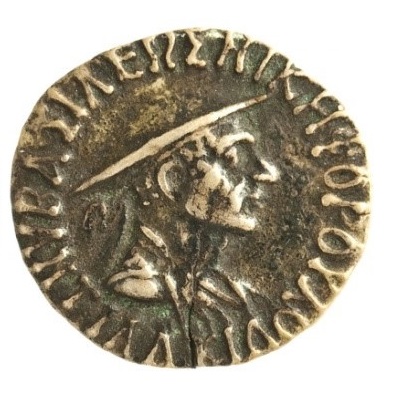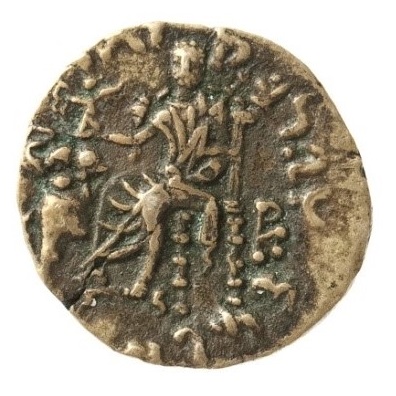Acquisition number: 1966.72
Obv.: Bust of Antialkidas r., draped, wearing kausia. ΒΑΣΙΛΕΩΣ ΝΙΚΗΦΟΡΟΥ ΑΝΤΙΑΛΚΙΔΟΥ (‘of Antialkidas the victorious’).
Rev.: Zeus sitting l. on a throne, draped left hand on lap holding sceptre, right hand extended holding a figure of Victory, which carries a wreath. Below Victory is the forepart of an elephant, which has its trunk upraised as if to receive the wreath. To r., monogram. Around periphery, an inscription in kharosthi.
Title: Drachma of Antialkidas of Parapomisidai - 1966.72
Acquisition number: 1966.72
Author or editor: Douglas Kelly
Culture or period: Hellenistic.
Date: c. 110 BC.
Material: Metal - Silver
Object type: Coins - Greek
Dimensions: 16mm (w)
Origin region or location: Afghanistan
Display case or on loan: 5
Keywords: Coin, Greek, Baktria, Baktrian, Antialkidas, Parapomisidai, Hellenistic, drachma, Zeus, Kabul, Hindu Kush
Sylloge Nummorum Graecorum, USA, The Collection of the American Numismatic Society (New York, The American Numismatic Society, 1969-), 1085 - 93.
W.W Tarn, The Greeks in Baktria and India, CUP, 2010.
R.C. Senior and D. McDonald, The Decline of the Indo-Greeks, Monographs of the Hellenic Numismatic Society, 1998.
1966.72
Drachma of Antialkidas of Parapomisidai
2.33 g. 16 mm. c. 110 BC.
Obv.: Bust of Antialkidas r., draped, wearing kausia. ΒΑΣΙΛΕΩΣ ΝΙΚΗΦΟΡΟΥ ΑΝΤΙΑΛΚΙΔΟΥ (‘of Antialkidas the victorious’).
Rev.: Zeus sitting l. on a throne, draped left hand on lap holding sceptre, right hand extended holding a figure of Victory, which carries a wreath. Below Victory is the forepart of an elephant, which has its trunk upraised as if to receive the wreath. To r., monogram. Around periphery, an inscription in kharosthi.
Portraiture of real people evolved in the Hellenistic period; the coinage shows this well. The kausia was a broad-brimmed Macedonian felt hat, designed to ward off the sun. The legend on the obverse reads ‘of the king, the bearer of victory, Antialkidas’.
The kingdom of Baktria was roughly the old Persian satrapy in northern Afghanistan, south of the river Oxus and north of the Hindu Kush. The name Baktria was not applied to the territories in southern Afghanistan around Kabul and the north of the Punjab that were conquered by the Baktrian kings.
Baktrian kings minted on the Attic standard, with a drachma of c. 4.2 g., but there were only a few issues on this standard in the southern region, which used much lighter standards, derived from either the Persian siglos orlocal weights, or both.
The conquests south of the Hindu Kush came in the reign of Demetrios I, around c. 200-190 BC. After Demetrios’s death the Greek-ruled regions south of the Hindu Kush separated from the kingdom of Baktria, which was itself overrun by invaders from the steppes by c. 130 BC. The southern region was an unstable area that was often splintered into two or more petty kingdoms. That ruled by Antialkidas was in the region known to Greeks as Parapomisidai, around Kabul. This whole southern region was overrun by local peoples and newcomers from the steppes by about 70 BC.
Only coins from the Greek kingdom or kingdoms south of the Hindu Kush bear inscriptions in kharoshti, the script of a Prakrit language,duplicating the Greek. They are not found on coins of Baktria itself. On this coin the only syllables which can be read (from right to left) represent antialkidasa mahara[jasa jayahara]sa. The monogram probably indicates the mint of Gardez, about 113 kms south of Kabul.
Any account of the history of this region must rest on numismatic evidence to a degree unparalleled in any other part of the Greco-Roman world. After the pioneering but over-adventurous work of W.W. Tarn (TheGreeks in Baktria and India, Cambridge, 1951), supplemented by the numismatically more rigorous A.K. Narain (Oxford, 1957), study of these coinages continues. See Mørkholm, 180-182, 185-186.
Sylloge Nummorum Graecorum, USA, The Collection of the American Numismatic Society (New York, The American Numismatic Society, 1969-), 1085 - 93.
W.W Tarn, The Greeks in Baktria and India, CUP, 2010.
R.C. Senior and D. McDonald, The Decline of the Indo-Greeks, Monographs of the Hellenic Numismatic Society, 1998.

